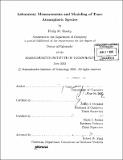| dc.contributor.advisor | Jeffrey I. Steinfeld and Mario J. Molina. | en_US |
| dc.contributor.author | Sheehy, Philip M. (Philip Michael) | en_US |
| dc.contributor.other | Massachusetts Institute of Technology. Dept. of Chemistry. | en_US |
| dc.date.accessioned | 2008-03-26T20:33:17Z | |
| dc.date.available | 2008-03-26T20:33:17Z | |
| dc.date.copyright | 2005 | en_US |
| dc.date.issued | 2005 | en_US |
| dc.identifier.uri | http://dspace.mit.edu/handle/1721.1/32491 | en_US |
| dc.identifier.uri | http://hdl.handle.net/1721.1/32491 | |
| dc.description | Thesis (Ph. D.)--Massachusetts Institute of Technology, Dept. of Chemistry, 2005. | en_US |
| dc.description | Vita. | en_US |
| dc.description | Includes bibliographical references (p. 129-145). | en_US |
| dc.description.abstract | Trace species play a major role in many physical and chemical processes in the atmosphere. Improving our understanding of the impact of each species requires a combination of laboratory exper- imentation, field measurements, and modeling. The results presented here focus on spectroscopic and kinetic laboratory measurements and photochemical box modeling. Laboratory experiments were conducted using IntraCavity Laser Absorption Spectroscopy (ICLAS), a high-resolution, high sensitivity spectroscopic method that had been used primarily for static cell measurements in the Steinfeld Laboratory at MIT. Several modifications and improvements have been made to expand its versatility. Firstly, a discharge flow tube was coupled with the ICLA Spectrometer, and the formation kinetics of nitrosyl hydride, HNO, were measured as a means to test the system. Secondly, a novel edge-tuner was introduced as a means to expand the spectral range of the ICLA Spectrometer. An experiment for the detection of the hydroperoxyl radical employing the edge-tuner in the ICLA Spectrometer is discussed and proposed. The results from the laboratory measurements are followed by the presentation of a near-explicit kinetic box model designed to improve our understanding of the oxidative capacity of the urban troposphere in the Mexico City Metropolitan Area (MCMA). The box model was constructed using the Master Chemical Mechanism and was constrained using a large dataset of field measurements collected during the 2003 MCMA field campaign. | en_US |
| dc.description.abstract | (cont.) The modeling is focused on the hydroxy and hydroperoxyl radicals (OH and HO₂), with an emphasis on the role of volatile organic compounds (VOCs) in the formation of both species. | en_US |
| dc.description.statementofresponsibility | by Philip M. Sheehy. | en_US |
| dc.format.extent | 145, [1] p. | en_US |
| dc.language.iso | eng | en_US |
| dc.publisher | Massachusetts Institute of Technology | en_US |
| dc.rights | M.I.T. theses are protected by
copyright. They may be viewed from this source for any purpose, but
reproduction or distribution in any format is prohibited without written
permission. See provided URL for inquiries about permission. | en_US |
| dc.rights.uri | http://dspace.mit.edu/handle/1721.1/32491 | en_US |
| dc.rights.uri | http://dspace.mit.edu/handle/1721.1/7582 | en_US |
| dc.subject | Chemistry. | en_US |
| dc.title | Laboratory measurements and modeling of trace atmospheric species | en_US |
| dc.type | Thesis | en_US |
| dc.description.degree | Ph.D. | en_US |
| dc.contributor.department | Massachusetts Institute of Technology. Department of Chemistry | |
| dc.identifier.oclc | 61858240 | en_US |
